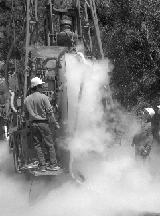

LBL RESEARCHERS HAVE PUT A COOL twist on the underground drilling used to clean up toxic waste sites. They have invented a drilling method that blasts super-cold nitrogen gas as it bores, creating frozen holes that won't collapse even in the sandiest of soils.

Nitrogen is injected down the drill's center pipe and exits through nozzles near the spinning drill bit. At -196 degrees C, the gas freezes difficult soils rich in sand, gravel or ash long enough for workers to insert stabilizing metal casings into the holes before the ground thaws.
The cryogenic method should be valuable to researchers trying to clean up contaminated grounds at many industrial facilities, closing military bases, and Department of Energy weapons laboratories, where loose dirt has often made it difficult to drill holes that do not cave in.
George Cooper, a researcher in the Earth Sciences Division at LBL and professor of petroleum engineering at the University of California at Berkeley, developed the technology with Rafael Simon, a UC Berkeley graduate student.
Boring holes in the earth is usually the first step in assessing contaminated areas. Soil samples taken from the holes tell scientists the types of pollutants that are present as well as their distribution. Drilling is also critical for removing contaminants from the ground, which can involve pumping pollutants out with groundwater or boiling them out with injected steam.
Unfortunately, cleanup experts at many facilities often find themselves faced with crumbling soils that will not hold their holes. "It's no coincidence that you find difficult soils at weapons labs -- they were built on land of little commercial value," Cooper says. "In the west this means sandy deserts. In the east this means agriculturally poor land, which often has sandy soil."
Drillers at contaminated sites are at a particular disadvantage since they can't use substances such as "drilling muds," the clay-based goo that is used to help stabilize bore holes. Drilling muds can complicate the cleanup effort by changing the permeability of the soil or spreading the contaminants further.
The cryogenic drilling should allow scientists to drill difficult holes at places like the nuclear cleanup site in Hanford,Washington, and other problem sites, such as the Savannah River site in South Carolina, Idaho National Engineering Laboratory, and the Oak Ridge Reservation in Tennessee.
Return to LBL Research Review Table of Contents